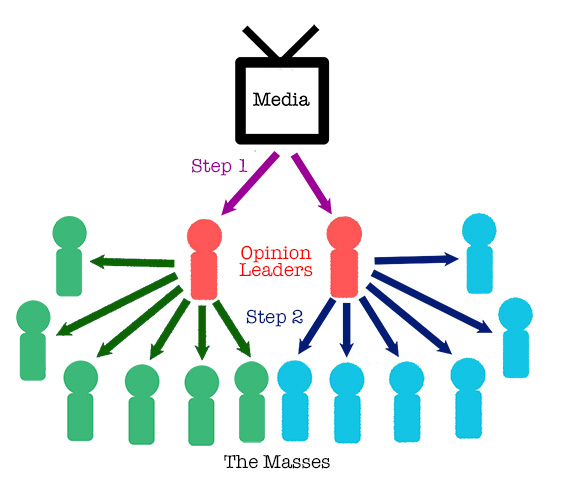The two-step
flow theory was introduced in the Era of the Scientific Perspective
(1940-1950). The three theorist Lazarsfeld, Bernard and Hazel researched on the
effects of media communication and found out that the impact of media is not as
influential as they once believed and stated that personal communication on
voting bases had a more substantial effect on the mass.
These
theorists observed that the ideas that print and radio media delivered to the
mass directly had a scarce effect. The importance of opinion leaders came to
light when the theorists observed opinion leaders gathering information from
the same media and interpreting it with their personal understanding and then
delivering it to the masses. Hence, the influence of opinion leaders was understood.
The effect that this flow of information had led to the establishment of the
two-step flow theory.
When talking
about appliance of this theory in the modern day one can safely assume that
this theory is not completely void. Researchers suggest that in the internet
age information is being passed in an extensive chain which consists of thousands
of sources which then spread information to thousands of other sources or in
simple words a global network of sources. These sources then forward their perception
of knowledge to millions of people around the world. Two step flow is identified
as the major limitation of this theory in modern day but the internet does not terminate
the concept of this theory it merely enhances it and looks at it with a magnified
view. Several examples of this can be seen throughout the Internet some of them
are mentioned bellow:
-
·
Yahoo
Answers
Yahoo
Answers is one of the best examples that supports two-step flow theory. It is a
platform which gives people an opportunity to ask questions and get answers on
various topics from a variety of opinion leaders. People tend to trust sources
that this platform provides. Hence the influence of opinion leaders is clearly
seen.
-
·
Quora
Like Yahoo Answers,
Quora also provides this opportunity. In Quora various opinion leaders get an
opportunity to share their ideas and beliefs and provide knowledge according to
their personal perception. People enjoy receiving knowledge from these pluralistic
speakers. These speakers talk about a variety of topics namely economics,
politics, social etc.
-
·
Blogs
Blogs are
another way opinion leaders use to convey their point of view. It establishes
the flow of information from the writer to the readers. In this modern society
blogs easily grabs the attention of the masses.
-
·
Advertisement
As most of
the theories of mass media the theory of two-step flow will have little or no
effect in the future. The creation of Internet has rendered this theory
insufficient. Therefore, this theory will probably be replaced by more complex
theories that will explain the complicated media of tomorrow but a part or a
reference of this theory will still remain for theorists to research on.
Answers.yahoo.com.
(2017). About | Yahoo Answers. [online] Available at:
https://answers.yahoo.com/info/about [Accessed 13 Feb. 2017].
Quora.com.
(2017). About Quora - Quora. [online] Available at: https://www.quora.com/about
[Accessed 13 Feb. 2017].
E. Dennis,
E. (2008). [pdf] Available at:
http://mj.unc.edu/sites/default/files/images/documents/ante/ante_two-step.pdf
[Accessed 13 Feb. 2017].
Communication
Theory. (2012). Two Step Flow Theory. [online] Available at:
http://communicationtheory.org/two-step-flow-theory-2/ [Accessed 13 Feb. 2017].
Utwente.nl.
(2012). Two Step Flow Theory. [online] Available at:
https://www.utwente.nl/cw/theorieenoverzicht/Theory%20Clusters/Mass%20Media/Two_Step_Flow_Theory-1/
[Accessed 13 Feb. 2017].




